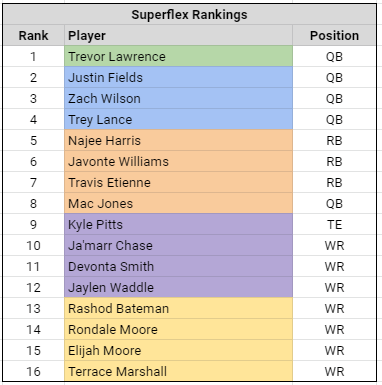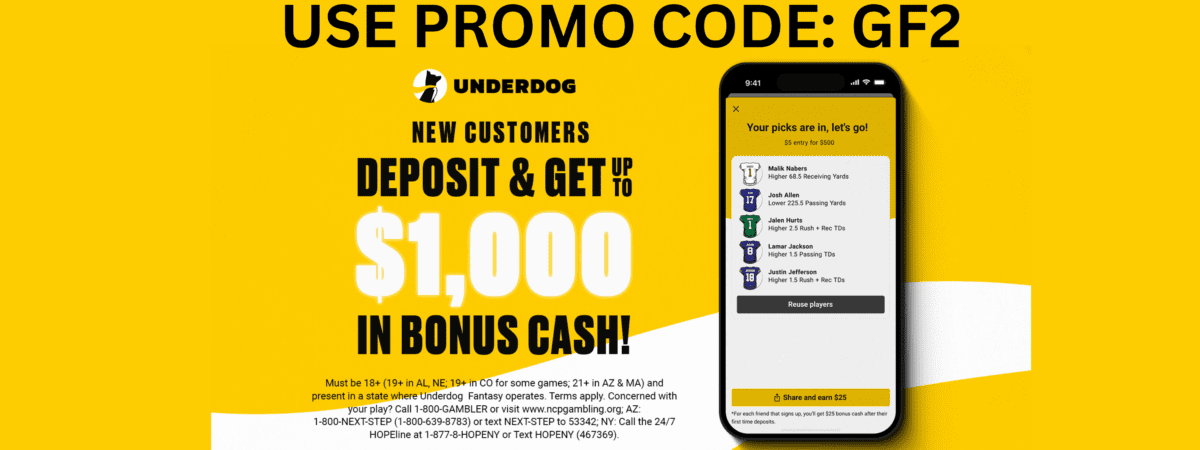How to Dominate Your Dynasty Fantasy Football Rookie Draft
In the Dynasty Fantasy Football community, Spring is the best time of year. The NFL Draft has become more or less a national holiday. A three-day event filled with twitter takes, live streams, podcasts, shredded mock drafts, Mel Kiper, and oh yeah…the draft itself! For your dynasty leagues, it also means the rookie draft, where you get to play NFL general manager and fill your rosters with potential stars. In my first ever article for goingfor2.com, I’m sharing strategies and insight to prepare you to dominate your rookie drafts.
Know Your League
Step one is obvious but very important. Know your league! Dust off those league by-laws and focus on roster size, taxi squad limits, and the number of rounds in the rookie draft. After the draft, you will have to make roster decisions to trim your roster down to the required size. How many players can you stash on your taxi squad? Does your league allow for second-year players to remain on the taxi squad? These settings can influence in-draft decisions, and later in the article, I will provide some examples to illustrate. Additionally, it would be best to have a good grasp of your opponents and their team needs.
Evaluate Your Team
Next, take an honest look at your team’s positional strengths and weaknesses. Furthermore, is your team a contender or a rebuilding team? Of course, this is something you should do routinely as a dynasty team manager, but it will once again play importance during the rookie draft as you seek out trades and ultimately make your picks.
Embed from Getty ImagesPrepare Your Rankings
Before your rookie draft, creating a set of rankings is an essential part of preparation. If you are new to the game or haven’t built your own ranks before, don’t stress, there are numerous sources with rankings from experienced analysts. Start with a set of rankings you trust and make your own customizations from there. Additionally, I would highly recommend tiering your rankings. In other words, create groups of players that you consider to be equal in value. Simply color-code your ranks with your tiers, and you’re good to go.

Lastly, add average draft position (ADP) to your rankings. For instance, Jonathan Taylor’s ADP in rookie drafts last year was 2.41 per ADP from My Fantasy League. Obviously, last year you were not selecting Taylor without a top pick of the draft. With ADP alongside your rankings, you will know how you value a player in relation to how others value that same player.
Embed from Getty ImagesNavigating Trades
It’s the day of the draft, you’ve done the prep work, and the picks are going off the board. Before you are on the clock, you may be offered a trade, or you should be seeking a trade. Trades are one of my favorite parts of rookie drafts and a way to get fantastic value depending on the situation. Let’s take a look at a few scenarios where trades could make sense for your team. For these scenarios, I will reference the tiers from above.
Trading Up
We are in the mid-first round of the draft, and Travis Etienne is the last running back available from your top tiers. However, your pick isn’t until the end of the first round. In this instance, if you want Etienne, you should be sending offers to all the managers with higher picks in hopes of upgrading. In rookie drafts, the most common trade packages I see are combinations of picks. Combining your pick with a decent second-round pick may allow you to jump up and get your guy. Additionally, understanding the team needs of your opponents can help you build the right package to get the deal done.
Embed from Getty ImagesPending your league’s restrictions on roster size and taxi squad, you may find yourself with too many picks. That may sound crazy, but I’ve seen rebuilding teams with as many as 12 or more picks in a rookie draft which can challenge roster management. In these scenarios, trading up to consolidate picks is a good strategy. Another strategy for this scenario is trading from your surplus of picks for picks in a future draft. For example, offer another manager two third-round picks this year for a second-round pick next year.
Trading Down
Another valuable move in rookie drafts is trading down. For instance, you hold pick one of round two. Your pick is up, and the four wide receivers from your tier are still on the board; Rashod Bateman, Rondale Moore, Elijah Moore, and Terrace Marshall. This is a perfect time to move back, still select a player from your tier, and get back additional draft capital. An example trade in this situation could be your pick for the third pick of the second round and a late second-round pick or early third. Imagine ending up with Elijah Moore and Amari Rodgers for Rashod Bateman. So channel your inner Bill Belichick, fire off those trade offers, and maximize the value.
Embed from Getty ImagesTrading as a Contender vs Rebuild
In my experience, I favor trading up when my team is a contender looking for that final piece to put my team over the top. Often a better idea as a contender may be to trade for proven talent. Draft picks are never more valuable than right before the draft or during it, making them fantastic trade chips. In the end, you are more likely to win the title this year with contributions from Calvin Ridley than Elijah Moore. In our example above, if Etienne goes off the board, then trading your pick for an established running back is an option you should absolutely explore.
Conversely, when your team is rebuilding, a common strategy is to stockpile as many picks as possible. A trade down in the can often yield additional picks, which increases the chances you will end up with solid fantasy assets at their lowest price. Think back a couple of years to Terry McLaurin’s ADP. He consistently went in the late second or even third rounds of drafts. An extra draft pick or two could jump-start your rebuild if you can land McLaurin later in the draft.
Embed from Getty ImagesMaking Your Pick
A common draft day choice is the decision between drafting for team need or drafting the best player available. I suggest going with a hybrid approach of taking the best player available within your tiers. This provides some flexibility for team need when your tier contains players from multiple positions. For example, if Mac Jones is in your current tier and your team is in desperate need of a quarterback, take Mac Jones. Try not to reach on players in lower tiers only to satisfy a team need. The average draft position data should help inform you if you are reaching for a player. In those cases, you should explore trading down instead.
Love our content? Check out the GoingFor2 Live Podcast Network!
As the draft shifts to later rounds, draft players with as much upside as possible, especially if your team is in rebuild mode. It does your team no good to select players with low ceilings that will provide little trade value in season and could end up clogging your roster down the line. Swing for that upside, and you could end up with a hidden gem, a valuable trade asset, or at the very least an easy cut next year when you’re managing your roster.
I hope this article has given you some insight on how to approach your rookie drafts. My final piece of advice, have fun! Remember, draft season is the best time of the year.
ATTN Dynasty Commissioners: Do you want to do something cool for your league? How about a 1-hour live show dedicated to YOUR league? Team-by-team breakdowns, rankings, and more. For details and to book a show, visit: GoingFor2.com/plp.






